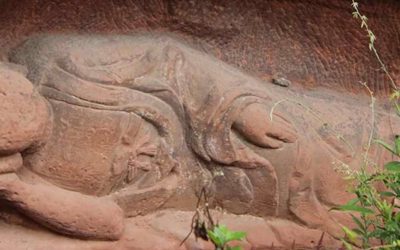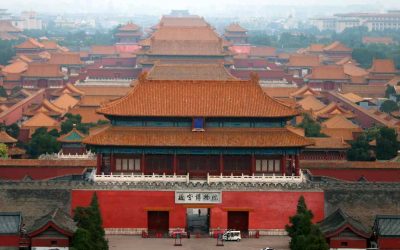Buddhist Monks in Medieval China
That is the subject of John Kieschnick’s book. The book analyzes the contents of the three collections of biographies of monks that became famous in medieval China, through them he tries to give us first a characterization of the external distinctives that made it possible to identify a monk during classical China. And in this, apart from his life in a community isolated from the rest of society, he emphasizes his abstinence from sex, meat, and wine, as well as wearing a different dress. Each of these circumstances is analyzed in some detail, showing that in some way we find an idealization, that is, monks are not supposed to eat meat or drink wine, but it seems that it has not been so rare to find monks who violated these rules with one pretext or another, for example meat to strengthen themselves or wine as medicine.
Another slightly more interesting aspect is his discussion of monk celibacy as this is a very controversial topic in China. It has been very common for enemies of Buddhism to accuse Buddhist monks and nuns of leading depraved lives and having sexual relations with each other. The emphasis in the biographies is of course on following the rule and total abstinence from sex, but there are also situations, perhaps a bit legendary, such as that of the famous monk Kumarajiva who was forced to have sex, both in his place of origin, where he was made drunk to force him, and in China, where the emperor said that an intellect such as his could not be left to bequeath to an offspring.
The ascetic monk
After this somewhat general identification of the monks, the book is dedicated to presenting the three most charismatic types, adding a sort of appendix to show the characteristics of the monks of the Zen school. The first of these models is that of the monk as an ascetic, and here the truth is that it brings us so many examples of extreme asceticism, ranging from a life dedicated to fasting and prayer, to following the most rigorous laws that recommended not sleeping indoors or even lying down, as some monks do for years, to the bloodiest aspects, such as self-mutilation, especially burning or cutting off fingers and even ritual suicides. In this section, the author provides many interesting facts for all scholars of Buddhist and Chinese history.
The thaumaturge monk
The second is the monk as a thaumaturge, that is to say as a magician, as a creator of portents, and here the activity is fundamentally related to divination and charms or curses. As the author continually reminds us, these activities were forbidden in China during most of the dynastic period, but the prohibition sometimes affected more the objective of the divination than the fact as such, and many monks achieved fame in imperial circles after performing miraculous cures, ending drought, predicting certain changes or showing their divination skills.
The monk as intellectual
The third of the models characterized is the monk as intellectual and here we find a paradox, because many times the intellectual is not putting his wisdom at the service of the Buddha, but tries to inflict a defeat on those, generally also Buddhists, who confront them dialectically. There is a very important generation of Buddhist intellectuals, who were in fact a large percentage of the intellectuals and philosophers of medieval China.
In contrast to these three characteristics of the monks that we could consider in a certain way heroic, although the author at no time characterizes them in this way, we have the fourth type discussed in this book, which is that of the Zen Buddhists.
With them, we see the opposition to all these good qualities previously highlighted in the biographies, now what matters is not so much the study, and some Zen masters are famous for having burned books or having disdained them, but to keep the heart clean while waiting for enlightenment, it is no longer important the asceticism but to be able to lead that simple life that will allow at a certain moment to be the object of that enlightenment.
This book is definitely a very interesting work, which presents the reader with little-known aspects of the activity of the monks in China. It should be remembered, as the author does on numerous occasions, that these treatises, these official biographies were normative, and that of course most of the monks who lived outside the great Buddhist centers, the sacred mountains and the capital and other large cities, may have experienced and lived the religion in a completely different way. But we have not heard so much about them. The book sheds light on many interesting topics in the history of Buddhism in China.
We copy here a short paragraph of the book.
«In the Song Biographies we read, for example, of the Tantric monk Vajrabodhi (Ch. Jin’gang- zhi) summoned to the court of Emperor Xuanzong to make rain after all of the efforts of court ritual specialists to bring rain through offerings to the five sacred mountains and the four sacred rivers had failed. In an elaborate ritual, Vajrabodhi made offerings to the deity Amoghankusa and constructed a platform, at the same time painting an image of the Bodhisattva of Seven Kotis. Later, on a set date, the monk finished the image by painting in the eyes, a ritual known as «opening the vision» (kaiguang). At that moment, a wind whipped up in the northwest. Tiles flew off of roofs and trees were uprooted. Thundering clouds burst forth with rain, startling those near and far. And in the place of the altar, a hole broke through the room so that the sanctum was deluged. When dawn broke the next day, gentlefolk and commoners of the capital all said, «Vajrabodhi captured a dragon, which broke out of the room and flew away.» Hundreds of thousands of people daily came to look at the place. Such is the divine efficacy of the «platform ritual.»
Kieschnick, John. The eminent monk. Buddhist Ideals in Medieval Chinese Hagiography. University of Hawaii Press. Honolulu. 1997.
About me: I have spent 30 years in China, much of the time traveling and studying this country’s culture. My most popular research focuses on Chinese characters (Chinese Characters: An Easy Learning Method Based on Their Etymology and Evolution), Matriarchy in China (there is a book with this title), and minority cultures (The Naxi of Southwest China). In my travels, I have specialized in Yunnan, Tibet, the Silk Road, and other lesser-known places. Feel free to write to me if you’re planning a trip to China. The travel agency I collaborate with offers excellent service at an unbeatable price. You’ll find my email below.
Last posts
Buddhist Immersion from Shanghai: No Need to Board a Plane—Paradise Is Right at Your Doorstep
Buddhist Immersion from Shanghai: No Need to Board a Plane—Paradise Is Right at Your Doorstep Residents of Shanghai eager to learn more about Buddhist art and history often think they must undertake long journeys to reach the sacred mountains of this religion. What...
The Lost Mythology of Ancient China
The Lost Mythology of Ancient China Reconstructing the mythology of ancient China is a painstaking task that tries to characterize some legendary figures and situations based only on the few sentences about them found in later works by philosophers and historians. The...
How a Eunuch Was Created in 19th-Century China
How a Eunuch Was Created in 19th-Century China A wealthy eunuch would purchase a boy from a poor family. This boy had to be between seven and ten years old. He would be kept confined for two weeks and subjected to a very strict diet; he ate little. Use of...







